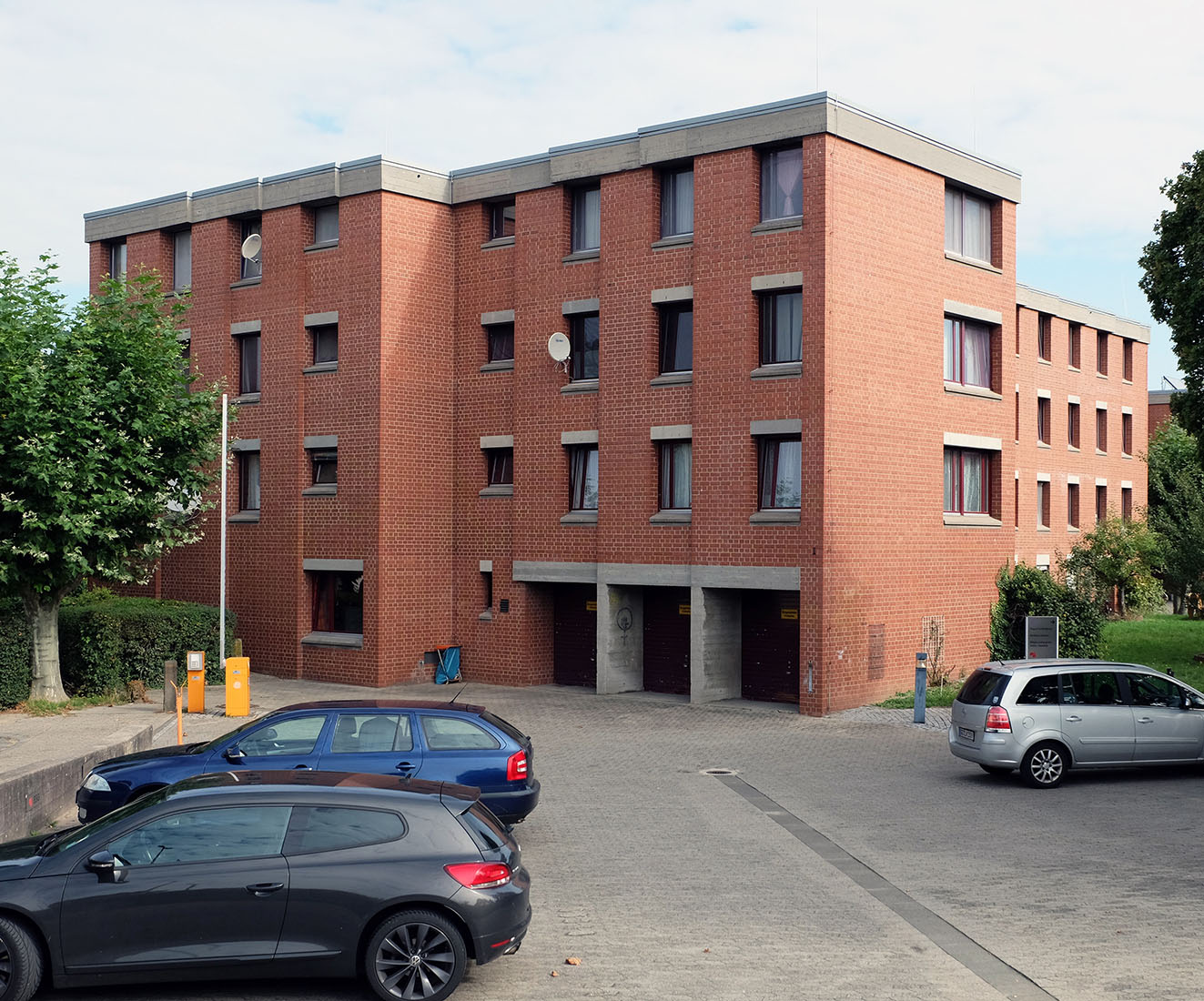 |
 |
 |
 |


Centre of the Protestant Studentcommunity and University Church Mainz
Am Gonsenheimer Spiess 1, Mainz
1964 - 1969
The contract for this building complex was the result of a competition on invitation, which had been carried out in 1964.
The student centre comprises a total of 117 single rooms, 6 two-room apartments for student couples, the university church,
the community halls and four flats for the student pastor and the staff. The complex is located in close proximity to the University,
but a lowered road forms a distinctive separation. To the west of the student center are low-rise residential buildings, on the east side
one encounters the catholic student hostel and to the north skyscrapers tower above all. Ernst Gisel responded to this complicated
urban situation in splitting the extensive program and grouping the volumes of the construction around a courtyard. The four-storey,
unilaterally orientend residential wings refer to the different orientations of the western and eastern neighboring building development.
A two-storey wing with the daily spaces of the community center is is put in front of the building complex. This tract forms a sort of
noise barrier to the street for the residential wings. The whole building complex is marked by extensive use of red brick. The lintels
over the windows and the roof edge are finished in exposed concrete.
The L-shaped courtyard is open to the southwest and has the character of a village square. In the center of the courtyard Ernst Gisel placed a fountain
which is also designed by him. The actual walls of this square are differentiated plastically: they are staggered, rounded, projecting and recessing.
In their fine scale of the modeling these plastic walls correspond to the cobbled floor. The cellular structure of the residential wings is represented
by the slight staggering of the facade to the outward side. This design feature was readopted by Ernst Gisel only little later in the residential wing of the high school in Vaduz.
The courtyard narrows to the north in a funnel shape and ends in the lobby of the University Church, which is hardly noticeable on the outside.
On the side of the courtyard, the church is recognisable by the more generous use of exposed concrete, to the exterior (north) side one one can recognise
a rounded wall. The interior of the church is formed as a "negative space". This negativ space is generated by the residential tracts extending in a north-south direction.
According to the ideas of the architect this church space should represent only a courtyard roofing. He explains that motifs reminiscent of traditional church
architecture were avoided from the outset. In fact, some traditional elements are present, which refer to the sacred function of the space.
These include an exedra as well as a gallery. Unfortunately, the building complex is now in a rather neglected state and the church
is in a pitiable state.
The student centre comprises a total of 117 single rooms, 6 two-room apartments for student couples, the university church,
the community halls and four flats for the student pastor and the staff. The complex is located in close proximity to the University,
but a lowered road forms a distinctive separation. To the west of the student center are low-rise residential buildings, on the east side
one encounters the catholic student hostel and to the north skyscrapers tower above all. Ernst Gisel responded to this complicated
urban situation in splitting the extensive program and grouping the volumes of the construction around a courtyard. The four-storey,
unilaterally orientend residential wings refer to the different orientations of the western and eastern neighboring building development.
A two-storey wing with the daily spaces of the community center is is put in front of the building complex. This tract forms a sort of
noise barrier to the street for the residential wings. The whole building complex is marked by extensive use of red brick. The lintels
over the windows and the roof edge are finished in exposed concrete.
The L-shaped courtyard is open to the southwest and has the character of a village square. In the center of the courtyard Ernst Gisel placed a fountain
which is also designed by him. The actual walls of this square are differentiated plastically: they are staggered, rounded, projecting and recessing.
In their fine scale of the modeling these plastic walls correspond to the cobbled floor. The cellular structure of the residential wings is represented
by the slight staggering of the facade to the outward side. This design feature was readopted by Ernst Gisel only little later in the residential wing of the high school in Vaduz.
The courtyard narrows to the north in a funnel shape and ends in the lobby of the University Church, which is hardly noticeable on the outside.
On the side of the courtyard, the church is recognisable by the more generous use of exposed concrete, to the exterior (north) side one one can recognise
a rounded wall. The interior of the church is formed as a "negative space". This negativ space is generated by the residential tracts extending in a north-south direction.
According to the ideas of the architect this church space should represent only a courtyard roofing. He explains that motifs reminiscent of traditional church
architecture were avoided from the outset. In fact, some traditional elements are present, which refer to the sacred function of the space.
These include an exedra as well as a gallery. Unfortunately, the building complex is now in a rather neglected state and the church
is in a pitiable state.